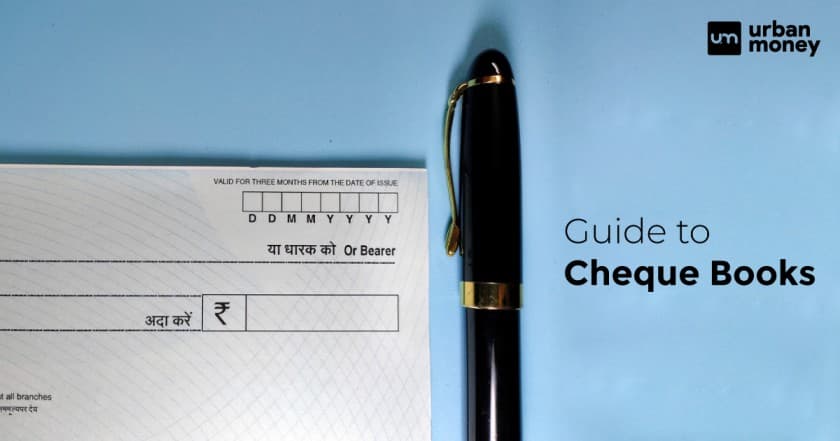What is a Cheque

- Personalized solutions
- Expert guidance
- Application assistance
- Credit score discussion
- Interest rate comparison


Last Updated: 12 January 2026
A cheque is a form of a bill of exchange addressed to the bank, where one party has initiated a request to transfer the fund amount mentioned to another party. Covered under the Negotiable Instrument Act of 1881, a cheque is a negotiable instrument. This three-party transaction involves the following:
- Drawer: The person who issues or writes the cheque.
- Drawee: Financial institution that has to facilitate the transfer of funds.
- Payee: Fund recipient or the person for whom the cheque was issued.
- Endorser: when the right to make payment from the drawer’s behalf is transferred to another party.
- Endorsee: when the right to receive payment payee’s behalf is transferred to another party.
Know Your Cheque
A cheque is a unique bill that is distinct from one another. A cheque would generally contain the following:
Cheque Number: Every cheque is distinct because of the unique Cheque number. It is found on the bottom left side of the cheque and contains six digits.
IFSC Code: A mix of numerals and alphabets, it is a unique 11-digit IFSC Code.
Bank Information: Refers to the name of the Bank and address.
Payee Information: Field is where the drawer is required to mention the recipient’s bank account information accurately.
Date Box: The drawer must mention the transaction’s date.
Account Number: it is essential to mention the account number to process the payment.
Signature: One must also sign the cheque with an accurate signature. Failure to do so can result in a cheque bounce. Nowadays, the drawer’s name is already printed on the cheque, and they must sign above it to validate the bill’s authenticity.
Amount: The drawer is required to write the amount to be transferred in words and numerals in the respective fields.
MICR Code: This is a nine-digit magnetic character recognition code that reflects the bank’s location and branch that issued the cheque to the account holder in the first place.
Features of a Bank Cheque
A Cheque entails the following characteristics and features:
- An account holder with a current or savings bank account can issue a cheque.
- One must keep the payee the same after the cheque has been issued.
- The amount, once written, must remain the same in the later stages.
- It is to be noted that a cheque is a physical document, and an oral deal between parties cannot be recognised as a cheque.
- A cheque is not a request but an order an account holder makes to their respective bank.
- Only when the cheque is signed and dated will it be valid.
- Any unsigned cheque would be deemed invalid.
- Cheques are valid from the date of issuance.
- If a cheque is signed, but the amount is not mentioned, such cheques are called blank cheques.
Types of Cheques
The following cheques are found in the country, each of which caters to varying requirements.
Bearer Cheque:
The bearer cheques are the kind of cheques that allows the bearer to encash the amount present on the cheque before the authorised bank.
Order Cheque:
It is a cheque where the payee can encash the cheque over the counter at the bank. However, it is to be noted that these kinds of cheques cannot be endorsed.
Number of Parties Involved with a Cheque (Covered)
How to Apply for a New Cheque Book?
The financial institution has established various avenues to apply for a new chequebook. One can apply for a chequebook through ATM, internet banking and mobile services. Let’s find out how an account holder can apply for a chequebook.
Apply for a New Cheque Book Via ATM
Many banks allow their account holders to apply for a chequebook through the ATMs established by them. The process varies from bank to bank and machine to machine, but in general, one is required to implement the below-mentioned steps:
- Visit the bank that allows applying for a chequebook via ATMs.
- Access your bank account by inserting your debit card and entering the PIN.
- Navigate to the option to apply for a new chequebook. It might feature options labelled ‘services’ and ‘other transactions’.
- You must accurately follow the instructions provided to conclude the chequebook application process. One may be asked to enter details such as the number of leaflets required in the chequebook or mailing address.
- You will receive a receipt confirming the request made. You must safe keep the receipt for records.
- You’ll receive the cheques within a few days at your mail address.
Apply for a New Cheque Book using Internet Banking.
The account holder can also apply for a cheque from the comfort of their home in case they have internet banking. It is a very popular method to apply for a cheque, as one is not required to make any physical visitation. Generally, one is required to take the following steps to apply for a chequebook via internet banking.
- Login into your internet banking account through your credentials.
- Navigate to the ‘manage your account’ section of the dashboard.
- Find the option on the menu that concerns a new chequebook request. One can find it in the ‘Services’ tab or the ‘Cheques’ and ‘Chequebook’ options.
- After clicking on the option, one is required to request the issuance of a new chequebook. You must input the account number and leaflet count on the cheque and confirm the request.
- The bank will send a confirmation email or message to you after processing the request. One can receive the chequebook at their mailing address and track the status of the chequebook.
Apply for a New Cheque Book using a Banking Application
The account holder can also apply for a chequebook from the mobile application bank designed by the bank to cater to such requirements.
- Log in to the app via your Customer ID and password.
- Navigate to the option for the ‘chequebook request’ or ‘services’ tab from the main dashboard.
- Select the option and provide all the necessary information, such as the leaflet count on the chequebook or the kind of cheque you want.
- Fill out other necessary information such as the mailing address, phone number, and additional contact information.
- Submit the request, and after the bank process the application, the chequebook will be delivered to the mailing address.
Apply for a New Cheque Book via SMS
In case one is unfamiliar with the intricacies of ATMs and internet banking, the bank offers mobile services through which one can easily apply for their chequebook.
- Visit the bank’s official website and find the toll-free number for customer care.
- Request for SMS services updates after calling the number.
- The customer service representative will provide instructions through which one would be able to apply for a chequebook.
- One must employ their registered mobile number with the bank to facilitate the process.
- After performing all the required steps and formalities, you will be notified of the expected date when receiving the chequebook via post.
Chequebook Validity
Per the Guidelines of the Reserve Bank of India, the validity of the chequebook from the date of issuance of the bill has been determined at three months. One must encash the bill within the time frame to conclude the transaction.
Chequebook Lost
In case the chequebook of an account holder is misplaced or lost, one must file an FIR with the nearest police station. One can perform this function online too. The account holder must then reach out to their respective bank and initiate a request to stop all the payments by cheque from the account. The account holder is required to mention details such as the cheque number.
Chequebook not received
In case the account holder still needs to receive the chequebook within the allotted time after completing the application process. They can contact customer care services or visit the bank’s nearest branch to learn about the same.
Chequebook Request Letter
As the name suggests, a chequebook request letter is an official request made to the bank where the account holder asks the bank to issue a chequebook with the number of leaflets mentioned. The number of leaflets in a chequebook can range from 25 to 100. It is a formal letter addressed to the bank, and one must mention essential details such as the account number.
(FAQs) Frequently Asked Questions About Cheque
How can I get a chequebook from the bank?
The account holder can obtain a chequebook through various online and offline avenues set by the bank.
Does the bank provide cheque book for free?
No, a fee is charged by the bank for the issuance of the chequebook.
How long is a cheque valid?
As per the guidelines from the RBI, a cheque is valid for three months from the date of issuance.
Can I use a 5-year-old Chequebook?
Yes, the cheque’s validity concerns the date on the cheque, not the date when the chequebook was issued.
Are old cheques still valid?
Yes, one can use old cheques to perform transactions as long as the date of issuance does not exceed three months.
